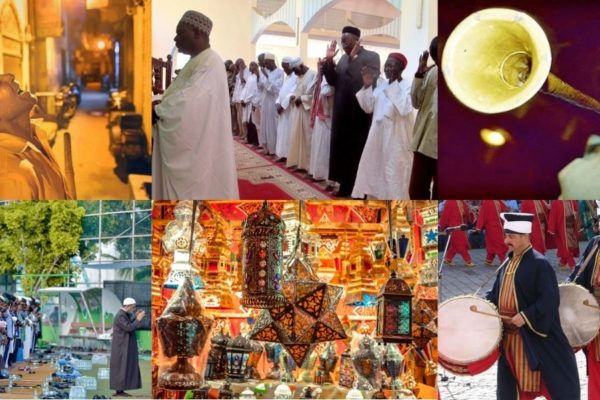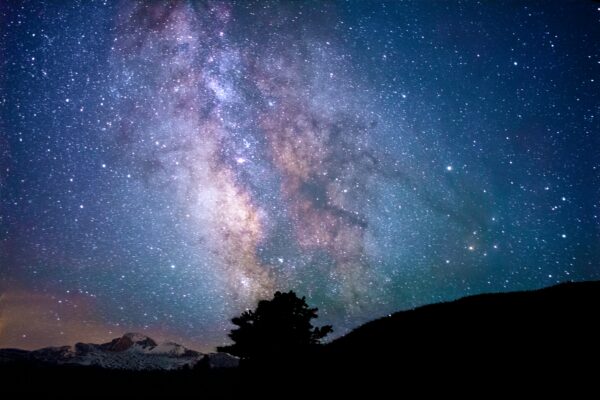The most beloved creation to God is His most perfect creation as perfection is the locus of God’s love, as a perfect being manifests His perfection. The greater the perfection the greater His love for that being.
The most beloved creation to God is His most perfect creation as perfection is the locus of God’s love, as a perfect being manifests His perfection. The greater the perfection the greater His love for that being.
Mystics have devoted much attention on God’s first creation as within the conception of the first creation lies the answer to the paradox of how sheer unity gives rise to a world of multiplicity. God is without limits and this is why His perfection cannot be fathomed.
When we consider His Attributes such as His Omnipotence, His Mercy, and His Grandeur, not only are we incapable of fathoming the extent of these perfections, but they do not have any real limit. God, in His Essence, is not limited to time, space or matter. This is the reason that His Attributes are One with His Essence. Neither the Essence or the Attributes are limited in any way. In fact, the conception of God as limitless does not leave room for another being to have any independent existence or for that being to have any perfection.
Indeed, all perfection, including existence, belongs only to God.[1] At the same time, multiplicity is intuitive as the corporeal world is one of limitation, and that limitation gives rise to individual beings that are not related to one another. As material beings, we sense our own limitations. The paradox is that any independent being, with its own perfection, its own power, its own mercy, and its own grandeur contradicts the vision of sheer unity. The emphasis on unity is special to Islam and is its principle doctrine. Unity, as it pertains to God, is not numerical oneness as that oneness allows for the conception of limitations.[2]
As the first creation cannot be an independent being, thinkers have struggled for terms for creation that can capture other than God, but not independent from Him. Such terms cannot indicate pantheism (ḥulūl) as God is beyond matter and is exalted above His creation. Muslim mystics have chosen two terms, as well as a few examples to try and express this complex relation.
The first word is manifestation (ẓuhūr). When God manifests He makes an aspect of Himself apparent in the clothes of the locus of manifestation. The opposite side of the coin of manifestation is that what is manifest acts as a veil to what it covers. If you bring a book close to your eyes, the book is manifest for you. But that manifestation veils everything else that was previously in your field of vision.
In order to explain the relationship between God and His creation further the example of a mirror is often cited.[3] A mirror manifests the image of what stands before it. The perfection manifested in the mirror is not owned by the mirror, even though the mirror seems to possess it and at the same time, all that can manifest in the mirror depends on the limitations of the mirror. If a small mirror is pointed towards a large mural, it will capture some of the beauty of the painting, but only to the size of the mirror.
Another example is of light as it shines through a window. The amount of light that brightens the room is limited to the size of the window.[4] In this sense, creation manifests God’s perfections as a mirror manifests the beauty of a mural. But, as mentioned previously it is important to remember that the creation is not independent in their existence. Unlike a mirror which is independent of its onlooker, creation is in constant need of God’s granting existence and perfection.
The example of creation here is not the mirror, but the image in the mirror which is completely dependent for its reality and perfection on the onlooker. So too creation is completely dependent on God. That existence and perfection is not from another source other than Him, as if the creation possessed their own existence and perfection, that would inevitably limit God’s existence and perfection.
The second term is self-disclosure (tajallī), which is a term juxtaposed to separation (tajāfī). When God created the creation, did He create that which was separate from Him? If so, then there are beings which are real and possess their own existence and this is a clear contradiction to His Unity, as that creation is separate to Him and independent of Him. While this is usually the way in which creation is conceived in order to distinguish God from His creation, it fundamentally challenges the unlimited nature of God’s perfection and His limitlessness.
Another possibility is to conceive of individual beings that are in complete need of God in every moment, but are somehow separate from Him. However, every time a level of strict dichotomy between God and His creation is envisaged, which is the purport of separation, the same problem ensues of the contradiction between unity and multiplicity.
For this reason, mystics have chosen the word self-disclosure, which doesn’t stipulate a strong separation between the Creator and the created, while at the same time holds onto a difference between them. The paradox of multiplicity and unity is replaced with another paradox of the Manifest and the manifestation, or the Disclosed and the disclosure. But the latter two paradoxes are not as dichotomous as the first, thus leaving enough room for the paradox to be solved. While that solution is intricate, and perhaps even better left unexplained, it is at the very heart of mystical rumination and deep religious experience.
Shīʿī scriptural sources discuss the first creation with a variety of expressions including the well-known tradition from the Prophet (saw) who was reported to have said: “The first thing that God created was my light.”[5] Other traditions that speak about the intellect,[6] His proofs,[7] the spirits of the Infallibles (as),[8] the pen[9], and the light of the Prophet (saw) or his (saw) spirit as the first creations of God.[10]
While these traditions may not stand up to the rigour of chain-based analysis, there are other traditions regarding the nature of the intellect that are on a much firmer grounding collectively both in terms of chain and meaning. When these traditions are brought together they paint a coherent picture of the first creation being the reality of the Prophet (saw) and the Infallibles (as) as they fully actualised the power of the intellect in all its dimensions.
Intelligence (IQ), emotional intelligence (EQ) and especially spiritual intelligence (SQ). The definition of SQ being that by which God is worshipped and heaven is attained. They were manifestations of the intellect in the macrocosm and as such were proofs upon the intellects within each individual on the level of the microcosm.[11] The reality of something is the source of its perfection, and from their (as) perfect intellects they (as) manifested the most noble of moral traits.[12] Indeed, one of the primary purposes of religion is to perfect the SQ of its adherents and thereby beautiful moral traits.
In an important tradition Imām al-Bāqir (as) is reported to have said:
“When God created the intellect, He sought a response from it and said: ‘Come forward,’ whereupon it came forward. Then He said to it: ‘Go back,’ whereupon it went back. Then he said: ‘By my Might and Majesty, I have not created a creature more beloved to me than you, and I have not perfected you except in whom I love. Indeed, you alone do I command, and you alone do I forbid, [according to] you alone do I punish and [according to] you alone do I reward.”[13]
The reality of the intellect is complete obedience to God, and that is how God is worshipped and heaven is attained. The most beloved creation to God is His most perfect creation as perfection is the locus of God’s love, as a perfect being manifests His perfection. The greater the perfection the greater His love for that being.
This is also what it means for something to be the first creation of God. First in rank rather than in time, especially considering that the first creations were metaphysical and as such were not limited by time and space which are limitations associated with the material realm and the isthmus (barzakh). It is through the Prophet (saw) and the Infallibles (as) that God’s commands and prohibitions are known and following that stage the intellection within each of us the benchmark by which we are rewarded and punished.
The reality of the intellect is the reality of the Prophet (saw) and the Infallibles (as) and then every believer to the extent of their realisation of their spiritual intellect. This is in the realm of creation (ʿālim al-khalq), but some mystics have gone further to explain the reality of creation in the realm of the Divine (ʿālim al-amr)[14] as the start of multiplicity in the sense of manifestation or self-disclosure is signified in a movement from the Unseen of the unseen to the level of individual Attributes.
Such rumination relies on a presupposition of coherence between each level of existence (qāʾidat al-munāsabat). The world of matter (al-mulk) and the metaphysical (al-malakūt) are in correspondence as otherwise there is no order in the decree which manifests in the corporeal world. That order has it source in the realm of the Divine which is the blue print of creation. Creation as a whole has its basis in the knowledge of God as it faces creation and so too the order that is witnessed within it.
The reality of the most perfect being corresponds to the manifestation of perfection within the realm of God as God is completely unknown in His Essence. He is known through the manifestation of His most perfect Attributes within the mirrors of creation and thus we are permitted to contemplate His signs and not His Essence. The most undelimited manifestation of His Essence, and thus His most perfect manifestation, is mirrored in the first creation which is the reality of the intellect and which is the reality of the Prophet and the Infallibles (as).
That is not to say that there are any other beings in the Realm or God. Rather, these ruminations denote that God is the source of this perfection that is manifest in His creation and the reality of that perfection. But, this is the level at which the coherence between the levels of existence ends, and beyond this level, God in His superabundance of every perfection is completely unknown at the level of the Unseen of the unseen (Ghayb al-ghuyūb).
Such ruminations by the mystics is extremely rich in philosophical purport as well as explanatory power and as such can only be challenged by frameworks that are of equal or greater strength. They may also be challenged on grounds of incoherency with the same scripture that they seek to explain, if such incoherency is found. But within their presuppositions, if these ideas are able to explain those sources in a coherent and consistent manner, it is only fair to accept these ideas as one way of explaining the scriptural sources. And God is the All-Knowing.
This article was originally published on Iqra Online, found here.
Footnotes
[1] See Qurʾān 1:1
حَدَّثَنَا مُحَمَّدُ بْنُ إِبْرَاهِيمَ بْنِ إِسْحَاقَ الطَّالَقَانِيُّ رَضِيَ اللَّهُ عَنْهُ قَالَ حَدَّثَنَا مُحَمَّدُ بْنُ سَعِيدِ بْنِ يَحْيَى الْبُزُورِيُّ قَالَ حَدَّثَنَا إِبْرَاهِيمُ بْنُ الْهَيْثَمِ الْبَلَدِيُّ قَالَ حَدَّثَنَا أَبِي عَنِ الْمُعَافَى بْنِ عِمْرَانَ عَنْ إِسْرَائِيلَ عَنِ الْمِقْدَامِ بْنِ شُرَيْحِ بْنِ هَانِئٍ عَنْ أَبِيهِ قَالَ: إِنَّ أَعْرَابِيّاً قَامَ يَوْمَ الْجَمَلِ إِلَى أَمِيرِ الْمُؤْمِنِينَ ع فَقَالَ يَا أَمِيرَ الْمُؤْمِنِينَ أَ تَقُولُ إِنَّ اللَّهَ وَاحِدٌ قَالَ فَحَمَلَ النَّاسُ عَلَيْهِ قَالُوا يَا أَعْرَابِيُّ أَ مَا تَرَى مَا فِيهِ أَمِيرُ الْمُؤْمِنِينَ مِنْ تَقَسُّمِ الْقَلْبِ فَقَالَ أَمِيرُ الْمُؤْمِنِينَ ع دَعُوهُ فَإِنَّ الَّذِي يُرِيدُهُ الْأَعْرَابِيُّ هُوَ الَّذِي نُرِيدُهُ مِنَ الْقَوْمِ ثُمَّ قَالَ يَا أَعْرَابِيُّ إِنَّ الْقَوْلَ فِي أَنَّ اللَّهَ وَاحِدٌ عَلَى أَرْبَعَةِ أَقْسَامٍ فَوَجْهَانِ مِنْهَا لَا يَجُوزَانِ عَلَى اللَّهِ عَزَّ وَ جَلَّ وَ وَجْهَانِ يَثْبُتَانِ فِيهِ فَأَمَّا اللَّذَانِ لَا يَجُوزَانِ عَلَيْهِ فَقَوْلُ الْقَائِلِ وَاحِدٌ يَقْصِدُ بِهِ بَابَ الْأَعْدَادِ فَهَذَا مَا لَا يَجُوزُ لِأَنَّ مَا لَا ثَانِيَ لَهُ لَا يَدْخُلُ فِي بَابِ الْأَعْدَادِ أَ مَا تَرَى أَنَّهُ كَفَرَ مَنْ قَالَ ثالِثُ ثَلاثَةٍ وَ قَوْلُ الْقَائِلِ هُوَ وَاحِدٌ مِنَ النَّاسِ يُرِيدُ بِهِ النَّوْعَ مِنَ الْجِنْسِ فَهَذَا مَا لَا يَجُوزُ عَلَيْهِ لِأَنَّهُ تَشْبِيهٌ وَ جَلَّ رَبُّنَا عَنْ ذَلِكَ وَ تَعَالَى «2» وَ أَمَّا الْوَجْهَانِ اللَّذَانِ يَثْبُتَانِ فِيهِ فَقَوْلُ الْقَائِلِ هُوَ وَاحِدٌ لَيْسَ لَهُ فِي الْأَشْيَاء شِبْهٌ كَذَلِكَ رَبُّنَا وَ قَوْلُ الْقَائِلِ إِنَّهُ عَزَّ وَ جَلَّ أَحَدِيُّ الْمَعْنَى يَعْنِي بِهِ أَنَّهُ لَا يَنْقَسِمُ فِي وُجُودٍ وَ لَا عَقْلٍ وَ لَا وَهْمٍ «1» كَذَلِكَ رَبُّنَا عَزَّ وَ جَلَّ.
See Muḥammad b. Ali Ibn Bābawah (al-Sudūq), al-Tawḥīd (Qum: Jāmiʿat al-mudarrisīn, 1397) 83.
…الْوَاحِدُ بِلَا تَأْوِيلِ عَدَد…
See Muḥammad b. Yaʿqūb b. Isḥāq al-Kulaynī, al-Kāfī (Qum: Dār al-ḥadīth, 1429) (1) 341.
[3] This is example is inspired by a dialogue between Imām al-Riḍā (as) and ʿImrān al-Ṣābī in the court of Maʾmūn, see Muḥammad b. Ali Ibn Bābawayh, ʿUyūn akhbār al-Riḍā (as) (Tehran: Nashr-i jahān, 1420) (1) 172.
…قال عِمْرَانُ لَمْ أَرَ هَذَا إِلَّا أَنْ تُخْبِرَنِي يَا سَيِّدِي أَ هُوَ فِي الْخَلْقِ أَمِ الْخَلْقُ فِيهِ قَالَ الرِّضَا ع أَجَلُ «1» يَا عِمْرَانُ عَنْ ذَلِكَ لَيْسَ هُوَ فِي الْخَلْقِ وَ لَا الْخَلْقُ فِيهِ تَعَالَى عَنْ ذَلِكَ وَ سَاءَ عِلْمُكَ مَا تَعْرِفُهُ «2» وَ لا قُوَّةَ إِلَّا بِاللَّهِ أَخْبِرْنِي عَنِ الْمِرْآةِ أَنْتَ فِيهَا «3» أَمْ هِيَ فِيكَ فَإِنْ كَانَ لَيْسَ وَاحِدٌ مِنْكُمَا فِي صَاحِبِهِ فَبِأَيِّ شَيْءٍ اسْتَدْلَلْتَ بِهَا عَلَى نَفْسِكَ يَا عِمْرَان…
[4] Rūhullāh al-Khumaynī uses this example to explain how all perfection is attributable to God and how all imperfection is attributable to the creation with reference to 4:78-79, see Rūhullāh al-Khumaynī, Junūd al-aql wa al-jahl, translated by Aḥmad al-Fahrī (Beirut: Muʾassasat al-ʿalamī lil-maṭbūʿāt, 2001) 29-30
[5] مشارق أنوار اليقين في أسرار أمير المؤمنين عليه السلام، ص: 44: غرر الأخبار، ص: 195: عوالي اللئالي العزيزية في الأحاديث الدينية، ج4، ص: 99: بحار الأنوار (ط – بيروت)، ج1، ص: 105
[6] عوالي اللئالي العزيزية في الأحاديث الدينية، ج4، ص: 99: الجواهر السنية في الأحاديث القدسية (كليات حديث قدسى)، ص: 289
[7] كفاية الأثر في النص على الأئمة الإثني عشر، ص: 171
[8] عيون أخبار الرضا عليه السلام، ج1، ص: 262
[9] تفسير القمي، ج2، ص: 198
[10] الوافي، ج1، ص: 52
[11] al-Kulaynī, al-Kāfī, (1) 35.
[12] al-Kulaynī, al-Kāfī, (1) 53.
قَالَ أَبُو عَبْدِ اللَّهِ عليه السلام: «أَكْمَلُ النَّاسِ عَقْلًا أَحْسَنُهُمْ خُلُقاً»
[13] الكافي (ط – دارالحديث)، ج1، ص: 23
[14] al-Khumaynī, Junūd al-aql wa al-jahl, 21-22.





